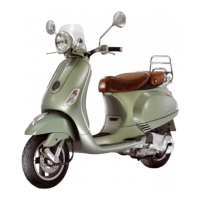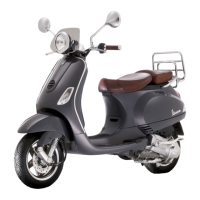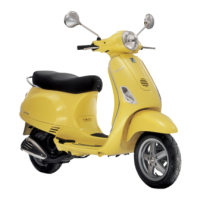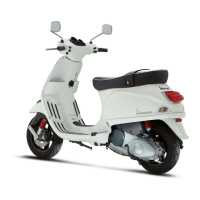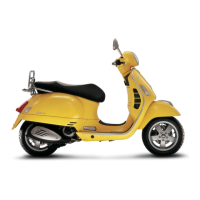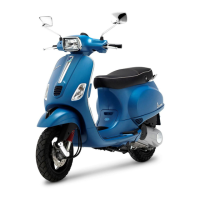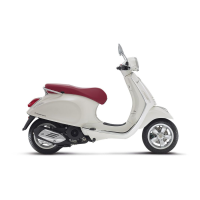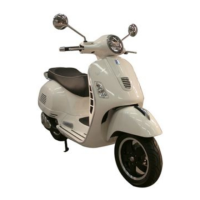Do you have a question about the Vespa LXV 125 and is the answer not in the manual?
General safety rules for maintenance operations on the vehicle, covering rules for work, battery, and fuel.
Technical data for the engine, including bore, stroke, cubic capacity, and cooling.
Details about the transmission system, including variator, V belt, and cooling.
Specifications for front and rear brakes, including disc and drum types.
Carburettor settings and specifications for the CVEK26 model.
Details on assembly clearances for cylinder-piston assembly.
Piston ring specifications for dimensions and clearances.
Axial clearance specifications between crankshaft and connecting rod.
Axial clearance specifications between crankshaft and its half-bearings.
List of specific tools required for vehicle maintenance and repair, with their codes.
Scheduled maintenance tasks based on time intervals or mileage for the vehicle.
Diagnosing and resolving issues related to poor engine performance.
Troubleshooting common starting difficulties, such as battery issues or flooded engines.
Troubleshooting steps for low oil pressure, including checking the by-pass and oil filter.
Diagnosing clutch issues like grabbing or slippage, and checking clutch masses.
Troubleshooting inefficient or noisy braking, including pad wear and fluid leaks.
Identifying causes of brake overheating, such as stuck gaskets or clogged pump holes.
Troubleshooting battery-related issues, including charging and maintenance.
Diagnosing and resolving heavy steering issues, checking bearing seats and ring nuts.
Troubleshooting excessive steering play, focusing on ring nut tightening and bearing wear.
Schematic and component legend for the ignition system.
Description and checks of the immobilizer system components and diagnostic codes.
Explanation of diagnostic codes and LED indicators for the immobilizer system.
Procedures and precautions for operations on the ignition circuit.
Troubleshooting steps when there is no spark at the spark plug.
Step-by-step guide for removing the entire engine from the vehicle's chassis.
Steps for refitting crankcase halves, including bulkhead, oil filter joint, and gasket.
Procedure for splitting the crankcase halves and removing the crankshaft.
Checking the axial clearance on the connecting rod.
Checking the radial clearance on the connecting rod and crankshaft surfaces.
Checking crankshaft bearing diameters and classification into categories.
Procedure for inspecting crankshaft alignment using a support and dial gauge.
Cleaning and inspecting crankcase halves, oil ducts, and mating surfaces.
Checking crankshaft plain bearings for lubrication, position, and driving depth.
Procedure for checking engine oil pressure at different RPMs and temperatures.
Steps for removing, inspecting, and refitting the oil pump.
Steps for removing the oil sump and inspecting the by-pass valve.
Procedure for inspecting the SAS valve's one-way function using a vacuum pump.
Procedure for inspecting the cut-off valve's vacuum operation and seal integrity.
Procedure for checking fuel supply and flow rate using a vacuum pump and burette.
Steps for removing and refitting the carburettor, including cleaning and adjustment.
Checking the automatic choke piston, gasket, protrusion, and resistance.
Procedure for adjusting the engine idle speed, including temperature and RPM checks.
Operations related to the front suspension system.
Procedures for removing, overhauling, and refitting the steering column.
Procedure for removing and refitting steering bearings, including seats and fifth wheel fittings.
Procedure for inspecting the brake disc thickness and deviation using a micrometer.
Steps for removing and refitting brake shoes and springs for the rear drum brake.
Items to check during a road test, including starting, controls, and performance.
Time allocation for belt/chain, chain pads, oil pump service/change, and oil sump replacement.
Time allocation for starter motor, cable harness, sprocket wheel, and kick starter replacement.
Time allocation for cooling fan, rotor, stator, and flywheel replacement.
Time allocation for carburettor resistor, manifold, fitting, choke, and carburettor replacement.
Time allocation for mirrors, levers, grips, handlebar, switches, brake pump, and throttle control replacement.
Time allocation for headlight switch, turn indicators, horn, starter button, key switch, and locks replacement.
Time allocation for brake hose, shoes/pads, caliper, fluid bleeding system, and rear brake pads replacement.
General safety rules for maintenance operations on the vehicle, covering rules for work, battery, and fuel.
Technical data for the engine, including bore, stroke, cubic capacity, and cooling.
Details about the transmission system, including variator, V belt, and cooling.
Specifications for front and rear brakes, including disc and drum types.
Carburettor settings and specifications for the CVEK26 model.
Details on assembly clearances for cylinder-piston assembly.
Piston ring specifications for dimensions and clearances.
Axial clearance specifications between crankshaft and connecting rod.
Axial clearance specifications between crankshaft and its half-bearings.
List of specific tools required for vehicle maintenance and repair, with their codes.
Scheduled maintenance tasks based on time intervals or mileage for the vehicle.
Diagnosing and resolving issues related to poor engine performance.
Troubleshooting common starting difficulties, such as battery issues or flooded engines.
Troubleshooting steps for low oil pressure, including checking the by-pass and oil filter.
Diagnosing clutch issues like grabbing or slippage, and checking clutch masses.
Troubleshooting inefficient or noisy braking, including pad wear and fluid leaks.
Identifying causes of brake overheating, such as stuck gaskets or clogged pump holes.
Troubleshooting battery-related issues, including charging and maintenance.
Diagnosing and resolving heavy steering issues, checking bearing seats and ring nuts.
Troubleshooting excessive steering play, focusing on ring nut tightening and bearing wear.
Schematic and component legend for the ignition system.
Description and checks of the immobilizer system components and diagnostic codes.
Explanation of diagnostic codes and LED indicators for the immobilizer system.
Procedures and precautions for operations on the ignition circuit.
Troubleshooting steps when there is no spark at the spark plug.
Step-by-step guide for removing the entire engine from the vehicle's chassis.
Steps for refitting crankcase halves, including bulkhead, oil filter joint, and gasket.
Procedure for splitting the crankcase halves and removing the crankshaft.
Checking the axial clearance on the connecting rod.
Checking the radial clearance on the connecting rod and crankshaft surfaces.
Checking crankshaft bearing diameters and classification into categories.
Procedure for inspecting crankshaft alignment using a support and dial gauge.
Cleaning and inspecting crankcase halves, oil ducts, and mating surfaces.
Checking crankshaft plain bearings for lubrication, position, and driving depth.
Procedure for checking engine oil pressure at different RPMs and temperatures.
Steps for removing, inspecting, and refitting the oil pump.
Steps for removing the oil sump and inspecting the by-pass valve.
Procedure for inspecting the SAS valve's one-way function using a vacuum pump.
Procedure for inspecting the cut-off valve's vacuum operation and seal integrity.
Procedure for checking fuel supply and flow rate using a vacuum pump and burette.
Steps for removing and refitting the carburettor, including cleaning and adjustment.
Checking the automatic choke piston, gasket, protrusion, and resistance.
Procedure for adjusting the engine idle speed, including temperature and RPM checks.
Operations related to the front suspension system.
Procedures for removing, overhauling, and refitting the steering column.
Procedure for removing and refitting steering bearings, including seats and fifth wheel fittings.
Procedure for inspecting the brake disc thickness and deviation using a micrometer.
Steps for removing and refitting brake shoes and springs for the rear drum brake.
Items to check during a road test, including starting, controls, and performance.
Time allocation for belt/chain, chain pads, oil pump service/change, and oil sump replacement.
Time allocation for starter motor, cable harness, sprocket wheel, and kick starter replacement.
Time allocation for cooling fan, rotor, stator, and flywheel replacement.
Time allocation for carburettor resistor, manifold, fitting, choke, and carburettor replacement.
Time allocation for mirrors, levers, grips, handlebar, switches, brake pump, and throttle control replacement.
Time allocation for headlight switch, turn indicators, horn, starter button, key switch, and locks replacement.
Time allocation for brake hose, shoes/pads, caliper, fluid bleeding system, and rear brake pads replacement.
| Engine Type | Single-cylinder, 4-stroke |
|---|---|
| Displacement | 124 cc |
| Cooling System | Air-cooled |
| Fuel System | Carburetor |
| Seat Height | 785 mm |
| Max Torque | 9.6 Nm at 6, 000 rpm |
| Length | 1, 770 mm |
| Front Brake | 200 mm disc brake |
| Rear Brake | 110 mm drum brake |
| Weight | 114 kg |
| Top Speed | 91 km/h |
| Transmission | Automatic CVT |
| Rear Suspension | Coil spring and hydraulic shock absorber |
